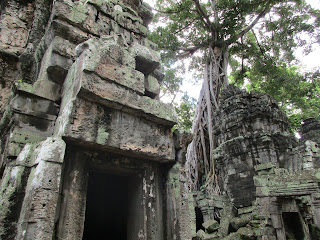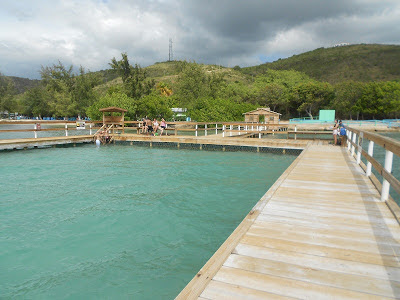Cambodia: Reflections and Highlights
I was really excited to visit Cambodia for a few days and hit up Angkor Wat and the other temples in the area. Cambodia felt like my kind of adventure--and I can’t even really say why. But I was excited. I was excited for our hotel there--a full-out boutique hotel (not a hostel), with AC, a swimming pool, breakfast included, and airport pick-up for free--which cost us a scant $20 per night. And we’d read about a lot of great tours we could take with local guides. Flying in and flying out, this leg of the trip would be a breeze, and hopefully everything would be as cheap as the hotel.
 |
| The Mango Rain Boutique Hotel |
Our flight to Cambodia was unlike any other I’ve ever been on. There were only about 20 of us on the flight--which would not have been strange, except it was, because we were on a full-size plane that could have seated 200. The 20 of us were mostly grouped together towards the back of the plane. Second impressive thing was that as soon as the plane got to altitude, the flight attendants came around and served a light meal. This, too, would not normally have been strange, except it was, because our fly-time was a mere 40 minutes or so. So it was the quickest meal service I’ve ever seen. Deliver the food...come around for trash...tray tables up; we’re landing!
 |
| Tuk tuk to the hotel |
Upon landing at around 8pm, we got our visas, cleared immigration, picked up our backpacks from baggage claim, and easily found the hotel driver who was waiting for us with a sign outside. As we seated ourselves in his tuk tuk, he offered us, in rather broken English, his tour guiding services for the temples of Angkor the next day. We hedged for more time; we had certainly planned to go with a researched and reputable guide, not taking a tour through the hotel. When we arrived at the hotel, though, the man checking us in again pushed the hotel’s tour. The price, to be fair, was indeed quite reasonable. But the “guide” barely spoke any English, and we wanted to learn about the history of the temples. We turned the tour down...and then went up to our room and started kicking ourselves.
We’d researched several good tour companies. We just hadn’t thought to reserve anything before arriving in Cambodia. Fine, except that now it was 9pm, most tours started around 7:30 in the morning (or earlier, if you took a sunrise tour), and we did not want to waste a day waiting for a guide to get back to us. We sent out several emails to tour guides, checked several websites, but getting a tour for the next morning was looking bleak. Then Liz thought to message a friend of hers who had recently been to Angkor. Elise responded immediately with a glowing review and contact information for someone she said was the best guide she’d ever had. We sent an email, and of course heard nothing, so the next morning at 6:30am, we tried calling Leap, the guide Elise recommended. He answered, and in perfect English apologized and said he was currently 2.5 hours away, and it just wouldn’t be feasible for him to guide us that day. He did, however, contact a colleague of his, and we gladly accepted these tour services.
It was around this point during our stay in Cambodia that I begin to get the constant feeling that I was being ripped off--but also that I should maybe be okay with that. I felt our tour guide was charging us too much (although he was indeed a quality guide, and his prices aligned with others offered in the area). Compared to the price of our hotel and the price of food at the street markets, though, the fee seemed outrageous. Furthermore, food was not included in the price of the tour, and of course the guide took us to a tourist trap restaurant (which admittedly had very good food) where he ate for free and we paid about 4 times as much as we would at a night market (and about double what we’d pay at a restaurant in town). The second day, the guide suggested we visit 2 more remote temples and see more of rural Cambodia on the way...and then he mentioned that we’d need to pay even more to cover transportation. In one of the cheapest countries in Asia, I did not expect to be paying $70-100 per day on tourism.
And yet...feeling this way also made me feel a bit guilty. Our guide was a local, building himself up from nothing, working freelance, which means he didn’t have a steady income...and really, had we been in the US, the tour would have cost as much or more. Same for the food. Were we in the US (or Japan, for that matter) the restaurants we stopped at would have been considered quite reasonable. So...was I just being stingy? Should I have been feeling more generous and giving with my money in such an impoverished country? Or was I right to feel ousted, wishing that my money could have been going elsewhere and to better causes in Cambodia? I’m still unsure. I know far too little about Cambodia to make an educated call on it; what is, is. It’s done, I paid, and in the long run, I could afford it.
Siem Reap is a town built by tourism, for tourists. In a way, this is a good thing. There are myriad restaurants and a huge night market. Prices are cheap and you can find a lot of fair trade handicrafts in the evening (regret of the trip: not buying that beautiful painting of an elephant. I could have transported it somehow…). The US dollar is accepted pretty much everywhere, and actually preferred to the Cambodian Real. The city was filled with tourists, and absolutely everyone we encountered spoke enough English to be able to help the tourists.
But in some ways, the tourist-centric town felt fake, forced, like we weren’t truly being exposed to the real Cambodia (and we weren’t; we saw the real Cambodia on day 2, when we drove for 3+ hours going from temple to temple).
I left with mixed feelings about the whole ordeal.
Without a doubt, though, the trip was worth it. The temples of Angkor are every bit as impressive, intricate, and amazing as the pictures on the internet had made them out to be. Our guide was very knowledgeable, and told us tons about the mythology behind the carvings of Angkor Wat and as much history as we could handle regarding the Khmer Rouge and the Cambodian genocide.
The first day, we hit up the main temples in the Angkor complex-- Angkor Wat, Angkor Thom, and Ta Prohm. Angkor Wat, of course, is the trademark view everyone knows. But what I didn’t know was that the walls are covered with crazy intricate carvings depicting both mythology and history. Our guide spent a long time telling us each story (and I promptly forgot most of them due to information overload).
 |
| Entrance to Angkor Wat |
 |
| "Churning of the Sea of Milk" |
Angkor Thom is a huge complex, the most well-known temple inside being Bayon. The temple looks like a jumble of rocks from afar, but up close, you can see that every surface there, too, is covered with sculpture. There are also 216 giant faces on the temple towers.
 |
| Gate to Angkor Thom complex |
 |
| Bayon |
 |
| aspara (dancing lady) carving at Bayon |
Ta Prohm is most well known because Tomb Raider was filmed there. I loved this temple because it’s been half taken over by the jungle. Trees grow out of the rock and threaten to pull down walls.
 |
| Ta Prohm entrance |
 |
| Ta Prohm |
Our second day, we made three stops: The Floating Villages of Chong Kneas, the remote temple of Beng Mealea, and to see the intricate carvings of Banteay Srei (the Lady Temple).
The floating villages are supremely interesting, and a whole post (or more) could be written about the culture and why and how they exist. I’m going to skip over all of that, though, and just write about our experience. Basically, what you need to know is that it’s a village on the water. House boats, but also floating markets, churches, schools, etc. When water levels change, people move their houses. It’s an extremely impoverished community, yet I was struck by the small touches to bring beauty. A bougainvillea growing in a pot outside someone’s door. The bright colors used to paint the houses. These little touches hinted to me that the people here must still have some hope, must still find pockets of joy in life.
 |
| It's that time of year! Moving the house from one spot to another. |
The next stop was a place called Beng Mealea. It’s pretty remote (about an hour and a half driving to get there), and when the Khmer Rouge was in charge, they set dynamite to it--trying to cut people off from their heritage, their religion. So there’s a large jumble of rocks and debris. Only recently were wooden walkways added; in years past, tourists had to scramble over the rubble. Aside from the pathways, the temple hasn’t been restored at all; the jungle has been allowed to take over.
 |
| Beng Mealea |
The final point of interest for the day was a small temple called Banteay Srei (another hour’s drive away). This temple, in contrast, has been beautifully restored and maintained. Almost every surface of Banteay Srei is covered in intricate, beautiful carving. Our guide told us that the sandstone at this temple is pink sandstone, of a much higher quality than that used to construct Angkor Wat, and for that reason has stood the test of time. At Banteay Srei, unlike Angkor Wat, visitors are not allowed to get close to or touch certain areas of the temple (and for good reason, I’d say!). There’s a pathway inside the outer walls, but the innermost structures are only able to be looked at, my touched or walked through. This temple is nicknamed “The Lady Temple” because legend says the art is so detailed and delicate here that it could only have been crafted by the hand of a woman.
 |
| One of the doorways in Banteay Srei |
 |
| Just look at that detail. After 800 years!! |
So that was our trip to Cambodia in a nutshell. Lots of exposure to a new culture, lots of learning and seeing history. Definitely one of the highlights of the entire trip to Asia.





Comments
Post a Comment